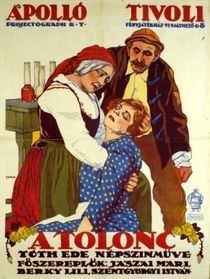| Reviews & Columns |
|
Reviews DVD TV on DVD Blu-ray 4K UHD International DVDs In Theaters Reviews by Studio Video Games Features Collector Series DVDs Easter Egg Database Interviews DVD Talk Radio Feature Articles Columns Anime Talk DVD Savant Horror DVDs The M.O.D. Squad Art House HD Talk Silent DVD
|
DVD Talk Forum |
|
|
| Resources |
|
DVD Price Search Customer Service #'s RCE Info Links |
|
Columns
|
|
|
Undesirable, The
What's more, The Undesirable (A tolonc, 1915) miraculously survives in a near-pristine condition, defying all odds. Watching silent movies today, generally masters derived from composite prints varying from fair to poor, it's easy to forget that these century-old photoplays were shot in the very same 35mm film format still in use today. To see a film from 1915 look almost brand-new is a revelation.
Even better, The Undesirable turns out to be pretty revelatory itself. Whether cutting edge filmmakers like D.W. Griffith influenced Curtiz or he was honing his art on a parallel but independent course this reviewer cannot say, but the film exhibits a level of sophistication that would place it awfully high compared to the crude and rudimentary form silent movies still often were in 1915. (Or 1914, sources differ about its precise release date.)
The acting, for instance, is exemplary, very naturalistic for the most part. The theatrically-trained leading actress, Lili Berky, is plump and resembles Griffith's Lillian Gish not at all but delivers the same level of emotional truth in her performance. She and most of the other actors do work that compares well with contemporary standards. Those who imagine all Hungarian actors as extravagantly theatrical in the Béla Lugosi manner (a star of silent films there himself around this time) will be pleasantly surprised.
This restoration of The Undesirable uses what appears to be the original English intertitles. They integrate seamlessly into the film though Anglicize all the names. Thus, Liszka becomes Betty (Berky), who learns during her father's deathbed confession that he's really her uncle. He adopted Betty after her physically-abused mother killed his brother, Betty's real father.
The now elderly mother, Sarah (Mari Jázsai), meanwhile, is released from prison after serving a 15-year sentence, hoping against hope to see her adult daughter before her death.
Betty finds employment as a maid for a wealthy middle-aged couple. Their handsome adult son, Nick (Victor Varconi, later a Hollywood character actor in films such as King of Kings and For Whom the Bell Tolls), falls head-over-heels for Betty at once. But the philandering if clownish husband (who's a bit like a Hungarian James Finlayson) crudely tries to grope Betty, some jewels go missing, and so despite the husband's reputation, the wife has "undesirable" Betty escorted back to her poor hometown.
The Undesirable resembles other silent films from the period in some respects while being much more sophisticated than most in others. Curtiz keeps the actors in long, static shots for interiors, scenes almost certainly filmed out-of-doors, as the occasional breeze makes curtains, tablecloths, etc. flutter noticeably. But the sets, flimsy though they may be, are often strikingly designed and very convincing. Exteriors are scenic and interesting, including location work in, presumably, the Carpathian Mountains of Transylvania. The story is reportedly based on a Hungarian folk tale, and appears to be set in the nineteenth century, based on the costumes, though by 1914 contemporary wardrobe in rural Hungary might not have looked all that different.
Curtiz exhibits little bits of visual poetry here and there: as the mother longs for her daughter, Curtiz perfectly superimposes an image of what the mother is thinking. The picture itself is short and sweet, barely running over an hour.
Video & Audio
Olive Films' Blu-ray sources a Hungarian restoration; a László Kovács is listed in the Hungarian language credits. Whether it's the famed cinematographer (who died in 2007) or somebody else is not clear, but it's possible he assisted in the project. The film elements aren't perfect, exhibiting some mild warping and other issues, and there are signs of digital cleanup here and there, but mostly The Undesirable looks sensational, and the 5.1 DTS-HD Master Audio of Attila Pacsay's score, which perfectly serves the film without drawing attention to itself, sounds great. Somewhat peculiarly, the disc comes with no Extra Features at all. It's as if The Undesirable just suddenly appeared out of nowhere.
Final Thoughts
A major find and restoration, The Undesirable is a DVD Talk Collector Series title.
Stuart Galbraith IV is the Kyoto-based film historian and publisher-editor of World Cinema Paradise. His new documentary and latest audio commentary, for the British Film Institute's Blu-ray of Rashomon, is now available.
|
| Popular Reviews |
| Sponsored Links |
|
|
| Sponsored Links |
|
|
| Release List | Reviews | Shop | Newsletter | Forum | DVD Giveaways | Blu-Ray | Advertise |
|
Copyright 2024 DVDTalk.com All Rights Reserved. Legal Info, Privacy Policy, Terms of Use,
Manage Preferences,
Your Privacy Choices | |||||||














